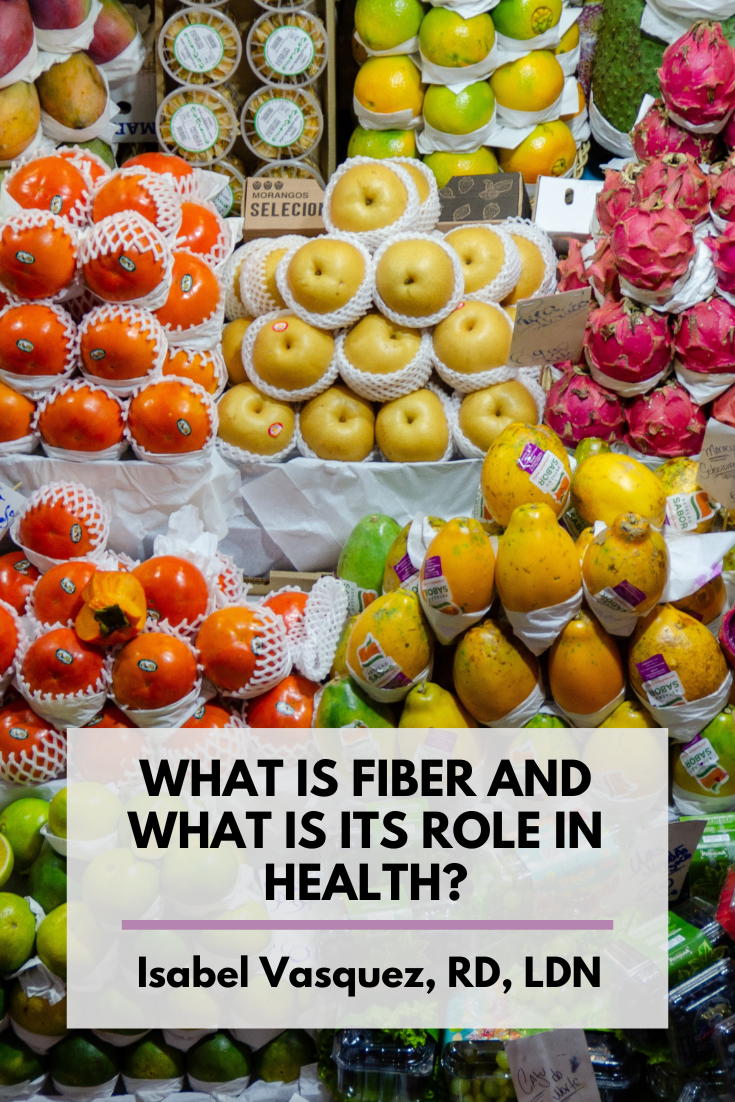What Is Fiber and What Is Its Role In Health?
Written by Isabel Vasquez RD, LDN
You’ve probably heard that adding fiber is beneficial for your health, but what even is it?
Fiber is a non-digestible carbohydrate that helps prevent constipation, reduce cholesterol, and stabilize blood sugars, according to the Centers for Disease Control and Prevention (CDC). It also helps us feel full because it contributes bulk to our meals.
Yet, fiber is one of the nutrients that Americans tend to under-consume, according to the U.S. Department of Agriculture (USDA).
While you may picture plates full of kale and green smoothies when you think of fiber, there are plenty of Latine cultural foods rich in fiber too.
In this blog, learn the two types of fiber, how much fiber to eat each day, and tips for consuming enough fiber.
Types of Fiber
There are two types of fiber: soluble and insoluble. Soluble fiber attracts water and becomes a gel-like substance during digestion. It may help manage diarrhea, and it has been shown to reduce cholesterol.
Some food sources of soluble fiber that are common in our Latine cultural dishes are beans, oats, papaya, and avocados.
The other type of fiber is insoluble fiber. This type does not attract water and it helps move things through our digestive system, so it can help prevent or treat constipation.
Some examples of insoluble fiber common in our Latine cultural dishes are yuca, corn, pineapple, and beans.
A lot of foods have a combination of soluble and insoluble fiber, so you’ll often get a mix of both when you consume fiber-containing foods like fruits, vegetables, and whole grains.
How Much Fiber Should You Eat?
Your daily fiber needs vary based on your age and sex. Here are the daily fiber recommendations for adults, according to the Dietary Guidelines for Americans:
Women age 19-30: 28 grams (g)
Men age 19-30: 34 g
Women age 31-50: 25 g
Men age 31-50: 31 g
Women age 50+: 22 g
Men age 50+: 28 g
For reference, ½ cup of black or pinto beans contains about 8 g of fiber and ½ cup of avocado contains about 5 g, per the USDA.
What Foods Are High in Fiber?
As noted above, fruits, vegetables, and whole grains are the best sources of fiber. Other plant foods like chia seeds and flax seeds are also good sources of fiber.
Here is the fiber content in some common Latine foods, per the USDA:
Sapote or sapodilla: 9.5 g per cup
Guava: 8.9 g per cup
Lentils: 7.8 g per ½ cup cooked
Soursop or guanábana: 7.4 g per cup
Yautia (or dasheen or taro root): 6.7 g per 1 cup cooked
Passion fruit: 6.1 g per ¼ cup
Chayote: 4.5 g per 1 cup cooked
Hominy: 4 g per 1 cup canned
Plantains: 3.1 g per 1 cup cooked
Nopales: 3 g per 1 cup cooked
Yuca: 3 g per 1 cup cooked
As you can see, root vegetables, fruits, and legumes that we commonly eat in Latin American dishes are great sources of fiber! So, to get in more fiber, you don’t have to resort to big green salads, you can do it by eating your cultural foods.
Tips For Eating More Fiber
If you think you could stand to eat more fiber, here are some tips and considerations for doing so:
Consider how you can add nutrition. Rather than adding fiber by restricting other foods, think about how to add more plant foods to your day in a way that’s satisfying and practical for you.
Be careful about ramping up your fiber intake too quickly. Quickly increasing your fiber intake can lead to digestive distress with symptoms like cramps, gas and bloating. Add fiber slowly to prevent these symptoms.
Be mindful of the diet mentality sneaking in. Notice your intention behind adding fiber, and be mindful if it is becoming disordered. Sometimes, diets tout fiber as a means of suppressing hunger which can lead to inadequate intake of other nutrients like protein, fats, and less-fibrous carbohydrates. Remember that we need nutritional variety, and one food group is not inherently superior to another.
Remember our Latine dishes are often rich in fiber. Our Latine dishes contain a variety of high-fiber foods including salsas, plátanos, avocado, and yuca. Adding fiber doesn’t have to mean ditching your Latine cultural foods for Eurocentric ones.
If you’re interested in learning gentle nutrition while improving your relationship with food and your body, our 3-part registered dietitian-led masterclass on intuitive eating is a great first step.
If you liked this post, you may also like:
Black Beans vs. Pinto Beans: A Complete Nutrition Guide

